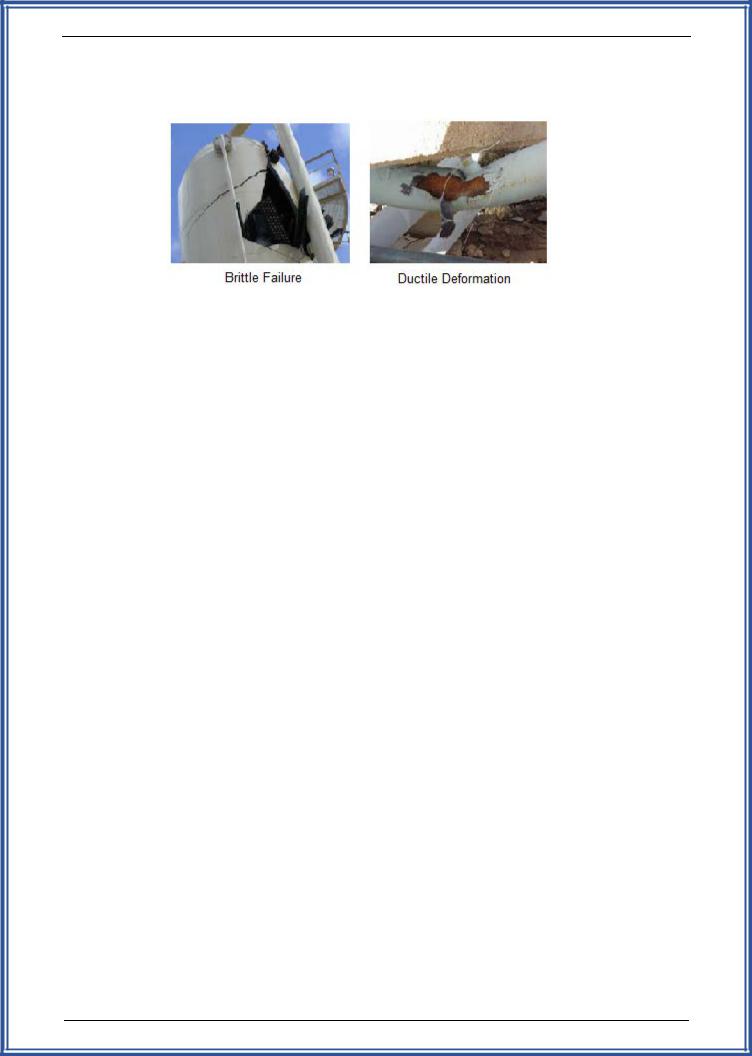
- •CHAPTER - 1
- •PIPING MATERIAL SELECTION & CHARACTERISTICS
- •1. Pipe Material Selection
- •1.1. Selection Criteria
- •1.1.1. Service Life
- •1.1.2. Code Requirements
- •1.1.3. Allowable Stresses
- •1.1.4. Design Temperature
- •1.1.5. Design Pressure
- •1.1.6. Corrosion
- •1.1.7. Economics
- •1.2. Characteristics of Piping Materials
- •1.2.1. Strength
- •1.2.2. Young’s Modulus (Modulus of Elasticity)
- •1.2.3. Stress-Strain Curve
- •1.2.4. Yield Point or Yield strength
- •1.2.5. Ultimate strength
- •1.2.6. Modulus of Elasticity
- •1.2.7. Ductility
- •1.2.8. Malleability
- •1.2.9. Hardness
- •1.2.10. Brittleness
- •1.2.11. Toughness
- •1.2.12. Creep
- •MATERIALS – METALLIC PIPING
- •2. METALLIC PIPES
- •2.1. Piping Material Specifications – ASME/ASTM
- •2.2. ASTM Material Designation
- •2.3. Pipe Grades
- •2.4. Carbon Steel (CS) Pipes
- •Characteristics
- •Applications
- •Standards
- •2.5. Killed Carbon Steel Pipes
- •2.6. Alloy Steel Pipes
- •2.6.1. Low Alloy Steel Characteristics
- •Standards - Pipes
- •2.6.2. High Alloy Steel Characteristics
- •2.7. Chromium Steel Pipes
- •2.8. Stainless Steel Pipes
- •2.8.1. Categories of stainless steels
- •2.8.2. Austenitic Stainless Steels
- •2.8.3. Ferritic Stainless Steel
- •2.8.4. Duplex and Super Duplex Steel
- •2.8.5. Martensitic Stainless Steels
- •2.8.6. Precipitation Hardening Stainless Steel
- •2.9. Cast Iron (CI) Pipes
- •2.10. Nickel and Nickel Alloys
- •2.11. Titanium
- •2.12. Zirconium
- •Some of the common service applications of Zirconium Piping include:
- •2.13. Chrome - Moly
- •2.14. Brass
- •2.15. Aluminium
- •2.16. Copper
- •2.17. Boiler and Heater Tubes
- •CHAPTER - 3
- •SPECIAL PIPING MATERIALS
- •3. PIPING MATERIALS FOR SPECIAL APPLICATIONS
- •3.1. Piping for High Temperature Service
- •3.2. High Temperature Materials
- •3.4. Cold Temperature Materials
- •3.6. Piping for Hydrocarbon Service
- •3.7. Typical Piping Specifications for Various Hydrocarbon Services
- •3.7.2. Sour Water Services
- •3.7.3. Hydrogen Exposure
- •3.7.4. Offshore Environment
- •3.7.5. Sulfides, Sulfurous Gases & Sulfur Environment
- •3.7.6. Oxidation
- •3.7.7. Halogenation Environments
- •3.7.8. Carburizing Environments
- •3.7.9. Nitriding
- •3.7.10. Amine Environment
- •3.7.11. Caustic Environment
- •3.7.12. Corrosion by Acids
- •3.7.13. Corrosion by Salts
- •3.7.14. Chloride Environment
- •3.7.15. Water Corrosion
- •3.7.16. Microbiological Induced Corrosion (MIC)
- •3.8. Applications for Cooling Water and Fire Water Systems
- •3.9. Measures for Corrosion Protection
- •3.9.1. External Corrosion Protection
- •3.10. Material Traceability
- •3.11. Material Test Reports (MTR)
- •3.12. Quality Assurance (QA)
- •3.13. Material Certificates
- •MATERIALS – UNDERGROUND PIPING
- •4. BURIED PIPING
- •4.1. Ductile Iron Pipe
- •4.2. Plastic Pipes
- •4.3. Types of Plastic Pipes
- •4.3.1. Thermoplastics
- •4.3.2. Thermoset Plastics
- •4.4. PVC Pipes
- •4.5. ABS (Acrylonitrile Butadiene Styrene)
- •4.6. Polypropylene (PP) Pipe
- •4.7. Polyethylene (PE) Pipe
- •4.8. PTFE (TEFLON) and PFA Pipe
- •4.9. Plastic Pipe Terminology
- •4.10. Plastic Pipe Designation
- •4.11. Standard Diameters
- •4.12. Dimension Ratio (DR)
- •4.12.1. Standard Dimension Ratio (SDR)
- •4.13. Pressure Rating
- •4.15. Plastic Pipe Standards
- •4.16. HDPE v/s PVC
- •4.17. Standard Sizes
- •4.18. Standard Lengths
- •4.19. Lined Piping
- •4.20. Cost Comparisons

Process Piping Materials – Module 2 – M06-036
CHAPTER - 3
SPECIAL PIPING MATERIALS
3. PIPING MATERIALS FOR SPECIAL APPLICATIONS
This chapter will discuss the piping materials for:
•High temperature service
•Low temperature service
•Corrosive and hydrocarbon service
3.1.Piping for High Temperature Service
Three primary design factors for high temperature service applications are:
•Service life (corrosion resistance and mechanical properties)
Strength and service temperatures are interrelated. For a prolonged anticipated service life of say 20 years:
−Plain carbon steels are usually limited to a maximum operating temperature of 750ºF;
−½ percent molybdenum alloy steels are limited to approximately 850ºF; and
−Stainless steels can be used to considerably higher temperatures.
•Allowable deformation
The rise in temperature is often associated with increased ductility and the corresponding lowering of the yield strength. The materials will overstress and fail in the elastic range. The failure in such a condition is referred to as a “creep failure” and is prevented by designing for reduced stress or temperature or by specifying a material with higher creep strength.
−When carbon steels are exposed to temperatures greater than 775°F (413°C) for long periods, the carbide phase may convert to graphite. Graphitization causes steels to experience brittle fracture at stress levels well below their short-term rupture strength. The rupture is often inter-granular with little or no deformation of the fractured surface.
46

Process Piping Materials – Module 2 – M06-036
When lowered below room temperature, the propensity for brittle fracture increases.
•Environment
−Elevated temperatures tend to increase corrosive action, heat transfer may affect corrosivity, thermal cycling can increase metal wastage through spalling of protective scale on the metal surface, and metal temperature probably will not be the same as the environment to which it is exposed.
3.2.High Temperature Materials
The table below gives the approximate temperatures for different materials before the onset of creep.
Material |
Maximum Temperature |
|
|
|
|
Carbon Steel |
800°F |
|
|
|
|
Carbon + 1/2 Molybdenum |
850°F |
|
|
|
|
P11 |
(1¼ Cr-½ Mo) Steel |
950°F |
|
|
|
P12 |
(1Cr-½ Mo) Steel |
950°F |
|
|
|
P22 |
(2¼ Cr-1Mo) Steel |
1000°F |
|
|
|
P91 |
(9Cr-1Mo-V) Steel |
1100°F |
|
|
|
Type 304/304L/316/316L/321/347 Stainless Steel |
1050°F |
|
|
|
|
Type H Stainless Steel (304H, 316H, etc.) |
1475°F |
|
|
|
|
800H (Incoloy) |
1750°F |
|
|
|
|
47

Process Piping Materials – Module 2 – M06-036
3.3.Piping for Low Temperature Service (Below 32°F)
Low temperatures have an undesirable effect on ductile steels, making them more prone to brittle fracture.
Strength, ductility, toughness and other properties are changed in all metals when they are exposed to temperature near absolute zero.
Project piping standards are generally based on the industry piping standard ASME B31.3. It requires that
•Non-impact tested carbon steel can be specified for piping with a minimum design temperature of -20°F (-29°C).
•Impact-tested carbon steel shall be specified with minimum design temperatures down to -50°F (-46°).
3.4.Cold Temperature Materials
MOC’s will be chosen to meet code requirements for brittle fracture mitigation. The basic materials selection philosophy used is:
•Carbon Steel (CS)
−For temperatures warmer than -20°F (-29°C)
•Low Temperature Carbon Steel (LTCS)
−For temperatures colder than -20°F (-29°C) but warmer than -50°F (-46°C). Impact tested CS should be specified.
Note - Low Temperature Carbon Steel (LTCS) is defined as carbon steel that has been impact-tested at a temperature colder than -20°F (-29°C) according to the mandatory requirements of the ASME/ASTM material standards (A333, A334, A350, A352, A420). No special alloying is employed to improve low temperature impacts.
•Austenitic Stainless Steel (Types 304 or 316)
−For temperatures colder than -50°F (-46°C).
ASTM A333 grades 1, 3, 4, 6, 9 and 10 pipes are suitable for low temperature service subject to satisfying appropriate impact test requirements below -50°F.
48

Process Piping Materials – Module 2 – M06-036
Generally, a buried pipeline will not be subject to very low temperatures unless buried in permafrost, so no specific caution beyond the general design considerations would be required.
3.5.Stress-corrosion cracking
Stress-corrosion cracking is caused by the combined effects of tensile stress and corrosion. Many alloy systems have been known to experience stress-corrosion cracking. For example:
•Brass in ammonia
•Carbon steel in nitrate solutions
•Titanium in methanol
•Aluminum in sea water
•Gold in acetic acid
•Some stainless steels (i.e. the austenitic grades) are susceptible to stresscorrosion cracking in chloride and caustic environments.
3.6.Piping for Hydrocarbon Service
All selections shall be based per ASME code for Process pressure piping, B31.3.
•Carbon Steel
The most common material used for hydrocarbon service is:
−Sch 80, Carbon Steel (CS), ASTM A106 Gr. B Seamless Pipe or
−API 5L Grade B Pipe
−A672 (specific grades) electric-fusion-welded pipe may be used for sizes >16”
•Carbon Resistant Alloys (CRA)
Where predicted corrosion rates for carbon steel are too high and where lining or other protection of the carbon steel is not practicable, Corrosion Resistant Alloy (CRA) materials shall be selected. Key environmental parameters influencing the corrosion properties of CRAs are:
−Temperature
−Chloride ion concentration
49
